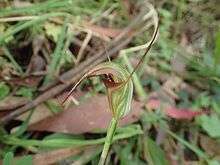Pterostylis abrupta
Pterostylis abrupta, commonly known as the tablelands greenhood, is a species of orchid endemic to New South Wales. It is distinguished from similar greenhood orchids by its thick, flat, platform-like sinus and blunt labellum which is only just visible above the sinus.
.jpg)
| Tablelands greenhood | |
|---|---|
 | |
| Pterostylis abrupta growing near Ebor | |
| Scientific classification | |
| Kingdom: | Plantae |
| Clade: | Tracheophytes |
| Clade: | Angiosperms |
| Clade: | Monocots |
| Order: | Asparagales |
| Family: | Orchidaceae |
| Subfamily: | Orchidoideae |
| Tribe: | Cranichideae |
| Genus: | Pterostylis |
| Species: | P. abrupta |
| Binomial name | |
| Pterostylis abrupta | |
| Synonyms[1] | |
Description
Pterostylis abrupta is a terrestrial, perennial, deciduous, herb with an underground tuber and a rosette of dark green, crinkled leaves, each leaf 10–25 millimetres (0.4–1 in) long and 10–15 millimetres (0.4–0.6 in) wide. A single flower 23–27 millimetres (0.9–1 in) long and 12–15 millimetres (0.5–0.6 in) wide is borne on a stalk 150–450 millimetres (6–20 in) high. The flowers are dark green, white and brown. The dorsal sepal curves forward with a thread-like tip 10–18 millimetres (0.4–0.7 in) long and with the petals forms a hood or "galea". The lateral sepals have a thread-like tip 30–40 millimetres (1–2 in) long and there is a protruding, platform like sinus between their bases. The labellum is 13–15 millimetres (0.5–0.6 in) long, 4 millimetres (0.2 in) wide, brown, blunt and just visible behind the sinus. Flowering occurs from December to April.[2][3]
Taxonomy and naming
Pterostylis abrupta was first formally described in 1985 by David Jones and the description was published in The Orchadian.[1] The specific epithet (abrupta) is a Latin word meaning "precipitous" or "steep".[4]
Distribution and habitat
The tablelands greenhood grows on ridges and slopes among rocks and grass in rich soil on the higher parts of the ranges and tablelands of New South Wales north from Barrington Tops.[2][3]
Use in horticulture
This greenhood is easily grows in pots although plants must be kept moist during the growing season and dry when dormant.[5]
References
- "Pterostylis abrupta". APNI. Retrieved 28 April 2017.
- Jones, David L. (2006). A complete guide to native orchids of Australia including the island territories. Frenchs Forest, N.S.W.: New Holland. pp. 287–288. ISBN 978-1877069123.
- Jones, David L. "Pterostylis abrupta". Royal Botanic Garden Sydney: plantnet. Retrieved 28 April 2017.
- Brown, Roland Wilbur (1956). The Composition of Scientific Words. Washington, D.C.: Smithsonian Institution Press. p. 210.
- "Australian terrestrial orchids". The Orchid Society of New South Wales. Retrieved 28 April 2017.